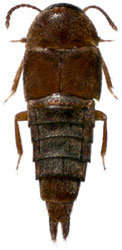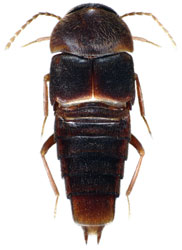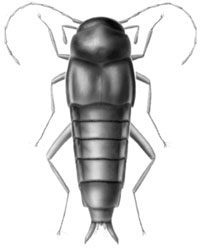Deinopsini
James S. Ashe (1947-2005) and Stylianos Chatzimanolis


This tree diagram shows the relationships between several groups of organisms.
The root of the current tree connects the organisms featured in this tree to their containing group and the rest of the Tree of Life. The basal branching point in the tree represents the ancestor of the other groups in the tree. This ancestor diversified over time into several descendent subgroups, which are represented as internal nodes and terminal taxa to the right.

You can click on the root to travel down the Tree of Life all the way to the root of all Life, and you can click on the names of descendent subgroups to travel up the Tree of Life all the way to individual species.
For more information on ToL tree formatting, please see Interpreting the Tree or Classification. To learn more about phylogenetic trees, please visit our Phylogenetic Biology pages.
close boxIntroduction
The Deinopsini are a small group of teardrop-shaped basal aleocharines that are characteristic inhabitants of marshes, bogs, pond and stream edges and similar riparian habitats. Deinopsine taxa occur in the Nearctic, Palearctic, Neotropical, Ethiopian, Oriental, and Australian faunal regions.
Characteristics
Deinopsines are similar to members of the Gymnusini, but they may be recognized by the combination of:
- very strongly deflexed head;
- lack of a tergal gland opening on abdominal tergum VII;
- pectinate edge of abdominal segments III-V;
- distinctive mouthparts (see Klimaszewski 1979 and Ashe 2002 for details);
- male tergum IX divided;
- head without setigerous pores;
- 2-2-2, 3-3-3 or 5-5-5 tarsal segmentation.
The three genera are superficially very similar, but they differ markedly in structure of the mouthparts, tarsi and genitalia.
Discussion of Phylogenetic Relationships
Klimaszewski (1979) provided a reconstructed phylogeny of the genera of the Deinopsini, and later (1980, 1982, 1985a,b 1992) he described more species and supplemented his revision. He proposed that the tribe is monophyletic based on the presence of a divided male tergum IX, and female sternum IX with 2 lobes and without valvulae. Among the four genera included in the tribe, he proposed that Metadeinopsis was the basal lineage and that Adinopsis and Deinopsis were sister groups based on derived features of the male copulatory organ and the presence of an elongate apical portion of tergum X in both males and females of these latter two genera (see Klimaszewski 1979 for details).
Recently, Ashe (2002) described Allodinopsis from Central America as a new genus. Though Ashe (2002) pointed out the striking similarities between Allodinopsis and Metadeinopsis, and hypothesized that they are very closely related, the phylogenetic placement of Allodinopsis has not been rigorously examined.
References
Ashe, J. S. 2002. Allodinopsis, new genus of Deinopsine Aleocharinae from Cetral America, and a new species of Metadeinopsis Klimaszewski 1979 (Staphylinidae: Aleocharinae: Deinopsini). J. Kans. Entomol. Soc. 75(2): 61-72.
Klimaszewski, J. 1979. A revision of the Gymnusini and Deinopsini of the World. Canada Agriculture monograph No. 25. 169 pp.
Klimaszewski, J. 1980. Two new species of Deinopsini from the Afrotropical and Nearctic regions, with notes on two other species of this tribe (Coleoptera, Staphylinidae). Polskie-Pismo-Entomologiczne. 50(1): 109-120.
Klimaszewski, J. 1982. A revision of the Gymnusini and Deinopsini of the World. Sup 2. Can. Entomol. 114(4): 317-335.
Klimaszewski, J. and F. Genier. 1985. A revision of the Gymnusini and Deinopsini of the World. Sup 3. Colepts. Bull. 39(1): 60-66.
Klimaszewski, J. 1985. Revision of the Gymnusini and Deinopsini of the world (Coleoptera: Staphylinidae). Supplement 4. New distribution data and description of female Adinopsis bicornis. Ent. News 96(4):142-144.
Klimaszewski, J. and J. H. Frank. 1992. New distributional data for New World Gymnusini and Deinopsini, with description of a new species (Coleoptera: Staphylinidae, Aleocharinae). Supplement 5. Coleopts. Bull. 46(3): 242-249.
Title Illustrations

| Scientific Name | Deinopsis illinoisensis |
|---|---|
| Location | Kansas, U.S.A. |
| Size | length 3.2 mm |
| Copyright |
© 1997 James S. Ashe (1947-2005)

|
| Scientific Name | Adinopsis sp. |
|---|---|
| Location | Ecuador |
| Copyright |
© James S. Ashe (1947-2005)

|
| Scientific Name | Metadeinopsis brunnea |
|---|---|
| Location | Paraguay |
| Size | length 3.6 mm |
| Copyright |
© 1997 James S. Ashe (1947-2005)

|
| Scientific Name | Allodinopsis howdeni |
|---|---|
| Location | Costa Rica |
| Size | length 2.6 mm |
| Copyright |
© 1997 James S. Ashe (1947-2005)

|
About This Page
Development of this page made possible by National Science Foundation PEET grants DEB 95-21755 and DEB 99-78110 to James S. Ashe.
All images on this page copyright © 1997-2003 James S. Ashe.
James S. Ashe (1947-2005)

University of Kansas, Lawrence, Kansas, USA
Stylianos Chatzimanolis

University of Tennessee at Chattanooga
Page copyright © 1997 James S. Ashe (1947-2005) and Stylianos Chatzimanolis
All Rights Reserved.
- First online 29 August 1997
- Content changed 06 November 2003
Citing this page:
Ashe (1947-2005), James S. and Stylianos Chatzimanolis. 2003. Deinopsini. Version 06 November 2003. http://tolweb.org/Deinopsini/9815/2003.11.06 in The Tree of Life Web Project, http://tolweb.org/














 Go to quick links
Go to quick search
Go to navigation for this section of the ToL site
Go to detailed links for the ToL site
Go to quick links
Go to quick search
Go to navigation for this section of the ToL site
Go to detailed links for the ToL site